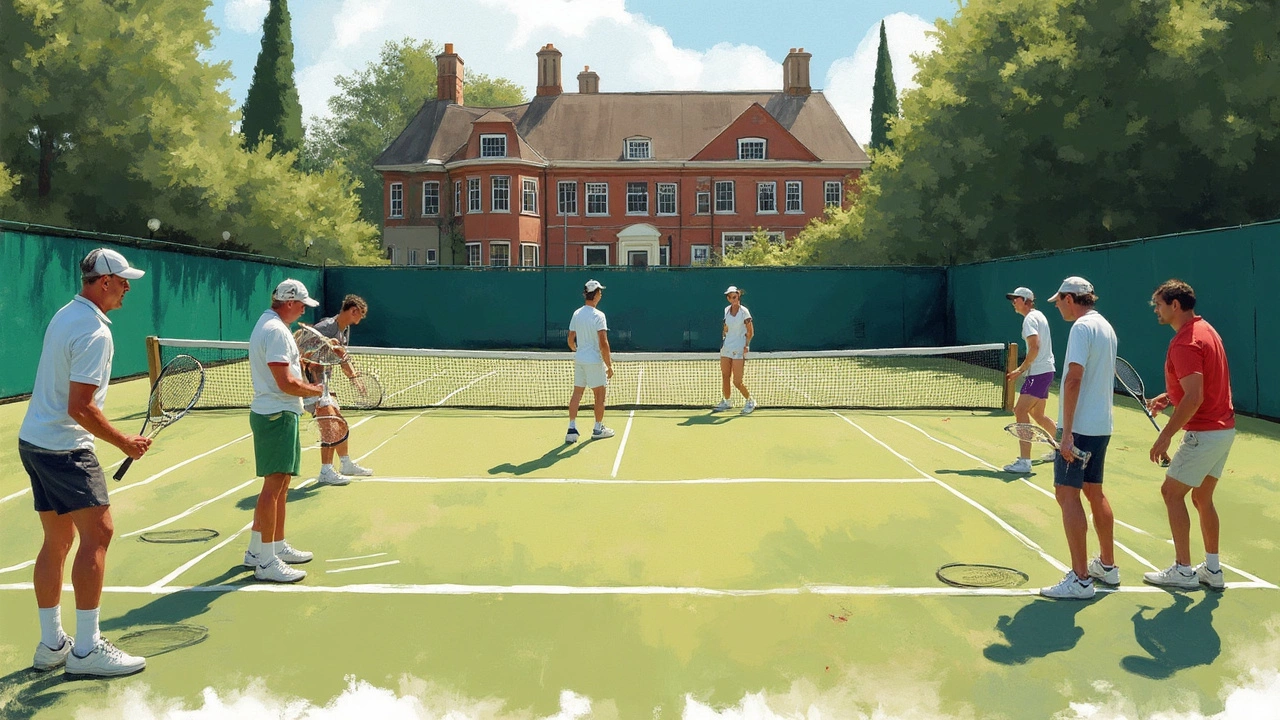How Good is a 4.0 Tennis Player? Skill Level Explained

People toss around tennis ratings all the time, but what does a 4.0 player actually play like? If you play any USTA matches or park leagues, you’ll hear this number a lot—especially because it’s kind of a sweet spot between the weekend warrior crowd and players who start getting serious.
So, is a 4.0 player any good? The answer might surprise you. A 4.0 is more skilled than most adults ever get. At this level, you can rally with confidence, hit with some topspin (and mean it!), and know when to go for that cross-court shot instead of just lobbing the ball back. You probably win most casual games at your club. But, it’s not pro-level, and the gaps between 4.0, 4.5, and 5.0 can feel like a canyon sometimes.
If you’re checking your own level for the first time, or wondering if you’re ready for a real local tournament, the 4.0 rating means you’re consistent and you know how to construct points, but you’re still working on finishing them like the big guns do. Let’s break down exactly what to expect on court, plus some tips if you’re aiming to hit that next high note.
- Understanding the 4.0 Rating
- What 4.0 Tennis Looks Like in Real Matches
- Strengths and Weaknesses at the 4.0 Level
- Tournament Experience and Competition
- How to Improve Beyond 4.0
Understanding the 4.0 Rating
The 4.0 tennis player label comes from the USTA’s National Tennis Rating Program (NTRP), which most leagues and tournaments in the U.S. use. So when someone says they’re a 4.0, it isn’t just a guess; they’re rating themselves—or are rated by officials—based on a common standard.
A 4.0 tennis player shows real skill beyond the basics. According to the USTA’s chart, a 4.0:
- Can consistently rally medium-paced shots with decent depth and control, using both forehand and backhand.
- Keeps up solid exchanges, even when the ball speeds up or the points get tricky.
- Can serve with direction, mix in some spins, and usually gets the ball in without just pushing it over.
- Knows basic strategy, so they’ll try to target opponents’ weak spots or change up their play if they’re losing ground.
- Handles volleys at the net with reasonable confidence, although they might not be crushing them all yet.
Here’s a quick look at how the USTA’s skill levels stack up next to each other:
| NTRP Level | What's Common |
|---|---|
| 3.0 | Basic rallies, more errors, limited direction |
| 3.5 | Longer rallies, starting to add spin and tactics |
| 4.0 | Consistent shots, better court sense, some attack shots |
| 4.5 | Aggressive play, finishing points, good anticipation |
If you’re wondering if you fit this mold, it helps to compare your play to these descriptions, or sign up for a USTA league and see where you land. Chances are, if you’re holding your own in weekly matches and making tactical decisions instead of just reacting, you might be a true 4.0.
What 4.0 Tennis Looks Like in Real Matches
If you watch a match between 4.0 tennis players, you’ll spot a few things right away. These players look like they actually know what they’re doing. They don’t just whack the ball and hope for the best. Instead, they rally with purpose, usually sending most balls cross-court and using topspin pretty well on both sides.
At the 4.0 tennis player level, points last longer. You’ll see ten-shot rallies that stay in the court, and serves that consistently land deep. They’re not blasting aces, but double faults aren’t super common either. And yeah, they will try to come to the net if they spot a weak, short ball. The volleys might not be rock solid yet, but most 4.0s have decent basics everywhere—even overheads and slices.
There’s also a clear difference in shot variety compared to lower levels. Drop shots, lobs, and angled shots show up way more. These players know when to play it safe and when to go for something riskier. You’ll notice that errors come from going for bigger shots or under pressure, not from a lack of basic control.
Check out this snapshot of typical stats in a 4.0 league match:
| Stat | 4.0 Player |
|---|---|
| Average 1st Serve In (%) | 65-75% |
| Unforced Errors per Set | 12-20 |
| Winners per Set | 5-12 |
| Net Approaches per Set | 6-10 |
It’s not just about strokes, though. There’s usually a lot more movement. You’ll hear players calling balls in or out, and they know basic tennis etiquette, which isn’t always a given at the 2.5 or 3.0 level. Matches at this level can be intense but fun, and the players genuinely start thinking about court position, not just chasing down balls.
If you’re thinking about entering a tournament as a 4.0, expect some tough, tactical tennis. You’ll need to be ready for players who can spot your weaknesses and actually attack them, especially in those third-set tiebreakers. Bring water and patience—it’s a grind, but a good one.

Strengths and Weaknesses at the 4.0 Level
Lots of people wonder what sets a 4.0 tennis player apart from the crowd. The big strengths usually come down to shot consistency, a higher tennis IQ, and the ability to handle different types of opponents (at least more than the average club player). They can rally both cross-court and down the line without falling apart. At this stage, most 4.0s can hit topspin, slice, and even some volleys well enough during a match—not just in practice drills.
Here’s what most 4.0 players can pull off pretty well:
- Consistent rallies: They can hit at least 10–15 balls in a row at medium pace, both forehand and backhand.
- Serve reliability: Double faults don’t wreck whole service games. A first serve usually goes in, though it might not be blowing anyone off the court.
- Basics of court positioning: They know where to stand during points, can recover after shots, and cover the net decently if they come in.
- Game plans: Trying out strategies like attacking a weaker backhand, throwing in drop shots, or mixing up spin isn’t out of reach here.
But even at 4.0 tennis player status, there are clear weaknesses—and they show up fast in tight matches or when nerves kick in. Most players at this level still struggle to finish points with put-away shots, especially under pressure. Footwork is good, but not explosive, so chasing down really wide balls can trip them up. Patterns break down if a player faces heavy topspin or a totally different style—think a strong counterpuncher or someone who serves and volleys all day.
- Finishing: Making the right shot is one thing, but executing it clean or with power? That’s hit-or-miss.
- Handling pace: Big hitters often expose holes in a 4.0s defense—fast, deep balls can result in rushed errors.
- Mental ups and downs: Players at this level sometimes let frustration or nerves lead to streaks of unforced errors, especially in close sets.
Check out this quick look at common skills you’ll see at 4.0—and which ones still need work:
| Skill Area | What 4.0s Do Well | Where They Struggle |
|---|---|---|
| Baseline Rally | Long, steady exchanges | Finishers when pressured |
| Serve | Reliable, few double faults | Lack of power or spin variety |
| Net Play | Decent volleys under pressure | Quick reflex volleys or overheads |
| Strategy | Basic plans, changes style if needed | Sticking with a plan when behind |
If you’re trying to level up, focus on cleaning up consistency under stress, working on your attacking shots, and mixing in new spins or angles. Those are the differences you’ll need to stand out in a tennis tournament at this rating.
Tournament Experience and Competition
If you’re a 4.0 tennis player, you’re smack in the center of the action when it comes to tennis tournaments. This level shows up in USTA leagues pretty much everywhere, and 4.0 events usually have bigger draws than almost any other skill group. Why? Most adult competitive players fall between 3.5 and 4.5—so the 4.0 group gets all the drama and the wild card upsets.
Here’s the reality: in these tournaments, you’ll see a little bit of everything. Some players come in fresh off a lesson, excited to test out their new backhand slice. Others are pure competitors, playing league tennis year-round. Matches are rarely one-sided. Expect 2 to 3 sets, lots of tie-breaks, and the sort of pressure where every second serve really counts.
If you’re looking to join a 4.0 event, you’ll need to be ready for:
- Long rallies and patient point-building. Players here don’t just whack at the ball—they’re thinking a few shots ahead.
- A good mix of playing styles. You’ll face heavy topspin hitters, counterpunchers, net rushers, and old-school flat hitters—all in the same weekend. Adaptability is key.
- More matches packed into one weekend than you might expect. Single elimination, consolation draws, or round robins are the norm, so you might play a handful of matches in two days.
- Line calls that are usually honest, but tempers can flare. There’s pride on the line, especially when advancing means new bragging rights around the club.
If you want to know what your competition might look like, here’s a quick peek at USTA data from last year for 4.0 adult tournaments in the US:
| Average Number of Players | Average Match Length | % of Matches Going to a Deciding Set |
|---|---|---|
| 24 | 85 minutes | 41% |
Playing at the 4.0 level is a test of nerves as much as skill. The pressure ramps up fast—especially in playoff situations or if a team slot is on the line. Strong serving, deep returns, and the ability to stay cool during close games make the difference here. And yeah, if you’re serious about moving up, it’s not just about skills—it’s about handling the ups and downs that come with real competition.

How to Improve Beyond 4.0
So, you’ve reached the 4.0 tennis player level, but what’s next? Moving up from here isn’t just about hitting harder—it’s about getting smarter, more consistent, and adding a few new tricks to your game.
At 4.0, most players already have reliable forehands, backhands, and serves. The difference between a 4.0 and a 4.5 usually comes down to a mix of shot selection, movement, and mental toughness. You’ll need to polish up these parts of your game:
- Consistency under pressure: Work on keeping your shots deep and inside the lines, even when you’re rushing or tired. It’s not enough to just rally—you’ve got to win the important points.
- Serve variety: A lot of 4.0 players rely too much on a basic flat serve. If you add kick and slice serves, you’ll keep opponents guessing and win more free points.
- Transition game: At 4.5, players come to net more and finish points off volleys. Start practicing approach shots and split-stepping at the net. Challenge yourself to win points at the net, not just from the baseline.
- Footwork drills: Most certified coaches agree: clean footwork is what separates 4.0 from the next level. Set up ladders or cones and train your split-step, recovery, and lateral movement.
- Match awareness: Think about your game plan before matches. Watch opponents’ patterns, notice where they’re weak, and learn to attack those spots. Some coaches suggest keeping a match journal to track what works and what doesn’t.
If you want real proof, check out this table showing the skills most cited by USTA raters as reasons for a 4.5 jump:
| Skill Area | % of 4.0 to 4.5 Promotions |
|---|---|
| Better Serve Placement & Variety | 38% |
| Improved Footwork & Court Coverage | 32% |
| Mental Toughness in Matches | 20% |
| Net Play/Volley Skills | 10% |
Practice matches matter—a lot. Try to squeeze in sets against higher-rated players. You’ll adjust faster to the extra pace and see what areas you need to patch up. Video yourself if you can, even on your phone. Sometimes you don’t spot a hitch in your serve until you see it in slow-mo. And don’t get discouraged—breaking into the next rating band often takes a year or more, even with intense focus.
Above all, enjoy the process. You get way more out of tennis when you’re mixing smart training and social matches. If you’re having fun, you’ll stick with it—and that’s how you climb past 4.0 tennis player and into the next club division.
